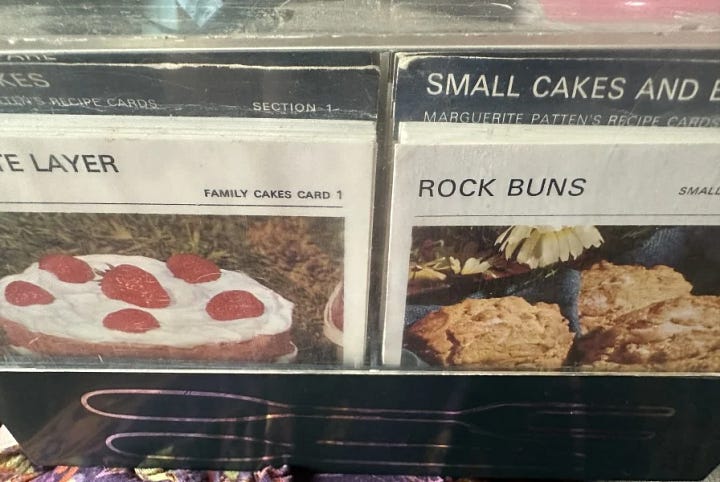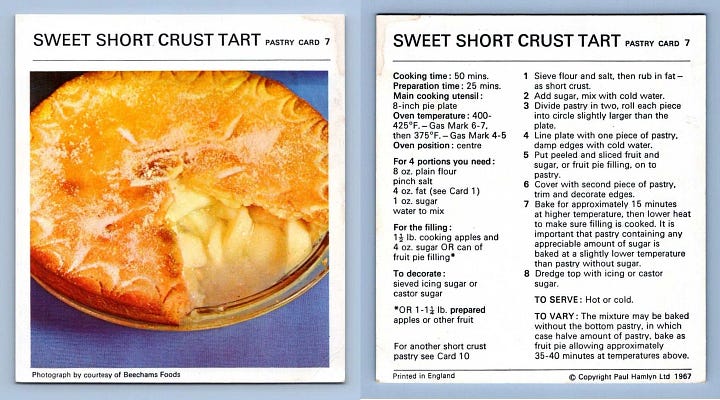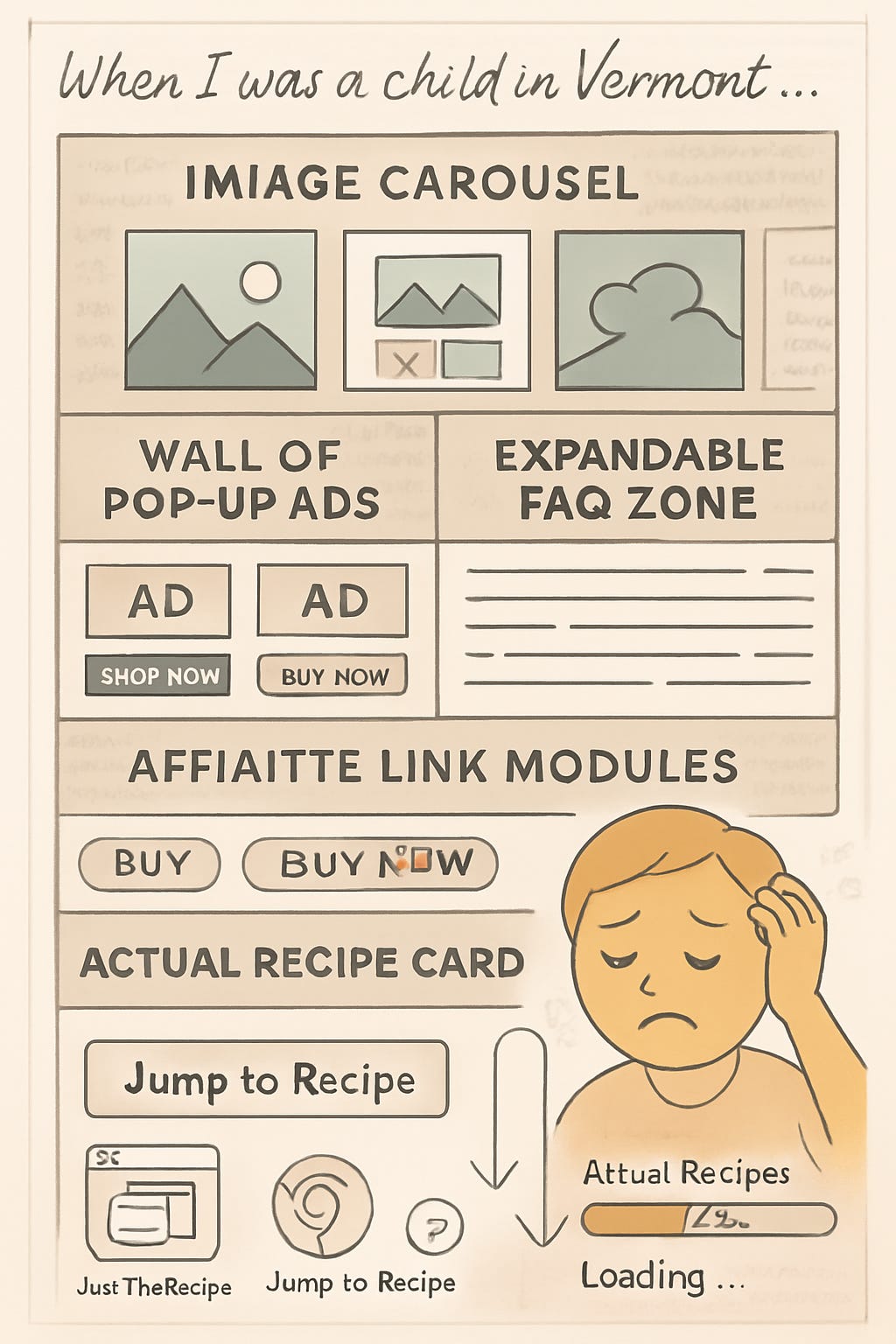Morbidly obese?
Recipe pages bloated to game search engines. Adipophilia now stalks product pages. We'll look at bloviated pages, and tsundoku... all in no particular order
I had a moment of irrational, long-suppressed rage about the bloat on product pages. Niche affliction, I know. Reading James Gurd’s must-read Inside Commerce newsletter (July 16th) he talks about the change from structured attributes on a product page to more narrative, AI-friendly (and AI-generated) content.
His example: changing the succinct attribute “Sustainability: made from recycled cotton” to
Sustainable materials - made with 85% recycled cotton. The versatile Mybrand backpack is made using 85% recycled cotton, a sustainable material sourced from consumer textile waste. Instead of sending unwanted clothes and factory scraps to landfill, we sort, clean and process them into new, high-quality fabric. Not only do we significantly reduce the need for new cotton, which requires large amounts of water, pesticides, and arable land to grow, but by repurposing our existing materials, we also reduce carbon emissions and minimise textile waste. We’re working hard to support a circular economy, extending the life of materials and reducing the fashion industry’s environmental footprint. And we do this while delivering quality and comfort.
Now, although I agree with James that the move to narrative, to emotive and to benefit-explaing is important, I had a wave of suppressed PTSD as I thought about recipe sites, and how so many add-nothing, search-pimping, factory-produced homespun fake pages filled the web, like an algal bloom in a stagnant pond on a humid summer’s day. Ugh.
So, I headed down this week’s rabbit hole on page-bloat.




Images of Marguerite Patten’s recipe cards: picture, method, ingredients. Job done! © ebay listings.
How to make food for your mouth
The humble online recipe used to be a scroll-length to an ingredients list, brisk instructions, and you were cooking. Digestible with sticky hands, on an iPhone, while cooking. #simples.
Now a simple search delivers a novella of childhood reminiscence, twelve hero shots, three advert blocks, and a FAQ obstacle course before the first ingredient is mentioned.
So painful is this bloat that there are browser extensions to literally erase the fluff.
The same forces of SEO folklore, AI-rewrites (by and for our robot overlords), ad monetisation, and rising disclosure mandates are already inflating e-commerce product pages. There are very good reasons for each element of the bloat, but let’s look at the mechanics, motives, and implications of today’s page-weight bloat epidemic and see where we head...
Scroll Rage: A Symptom of Recipe Inflation
Open TikTok and you will find half a million clips of home cooks punching the air when a blog finally reveals its ingredient list. Brooke Saylor’s eight-second screamer—“ALWAYS look for that jump-to-recipe button”—has 894,000 likes
Recipe posts routinely stretch beyond 1,600 words. RecipeKit teases somewhat on the average post length while noting that “400 would suffice to roast a chicken safely”. (See Do You Really Need a 2000-Word Recipe Essay for Good SEO in 2025?). The Real Naked Swedish Chef has a succinct post on this, but I can’t vouch ‘he’ is real, naked, Swedish or indeed a chef.
Cooks have moved beyond shrugging and TikTok venting and now use tools like JustTheRecipe.com (which parses a URL and returns just the ingredients and steps), or Cooked.wiki (which blends the scrape/simplify with an element of curation - ie I can create and share a list of my own scraped and simplified recipes…)1. Of course, the temptation to write 2,500 words about my motivation, family, cooking memories etc will remain strong, in order to game my position in the community…. No! Get thee behind me, SEO Satan!! 👺
Browsers who don’t want to maintain a mini-publishing activity can just use the “Jump to Recipe” extension for Chrome.
Order from/in chaos
SEO/AI bloated the recipe, AI scrapes and de-bloviates the recipe, but Google has stepped in with a positive approach - a schema for recipes. This is both a best-practice help and a way to draw out the information from the signal.
You can see the Google Recipe Schema on their developer site, but for fun just scroll to the JSON snippet example, copy the JSON, paste it into ChatGPT (or your favoured AI) and just ask “what is this?”. You’ll be treated to an explanation, commentary on the structure, the recipe and method…
The implication is that if you want to succeed in AI search, the answer is to use AI to prep for AI in the lightest possible and most structured way. Not to use AI to ape a verbally incontinent human obsessive bore - and then waste more AI to try to winkle out the meaning behind the brain-farts!
Anatomy of a Bloated Recipe
The recipe pages follow the same format as Instagram food reels, and comprise the following elements:
Hero memoir - 300–800 words - “Storytelling, personal connection”
Image carousel - 6–12 high-res images
Display ads each scroll - “Supports free content”
Affiliate module - 100–150 words + buttons - other shizzle to buy to help you cook
FAQ bunker - 400–600 words to increase dwell time and get traffic from people who ask “Can I freeze this soup?”
Three Forces Driving Culinary Copy Obesity
SEO Mythology – Early SEO advice equated ranking with sheer word count; surveys still show marketers target 1,500+ words as a “safe” threshold (https://getrecipekit.com/blogs/our-blog/why-word-count-doesnt-matter-in-recipe-seo; https://www.redsearch.com.au/resources/best-word-count-seo/).
Monetisation Mechanics – Ad networks pay per impression; longer scroll equals more viewable ad slots (https://real-naked-swedish-chef.com/views/layouts/kitchen_tips/stories.html).
“Authenticity Theatre” – Personal narrative signals originality, essential for copyright defence when ingredient lists themselves are not protectable, being pure fact.
This last reason is perhaps my favourite and also links to the theatre of fakery we see on social media.
Additional pressure on product pages
Turning to retail that are additional pressures leading to bloat:
Compliance & Disclosure – Sustainability claims, ingredient origins, warranty clauses, privacy disclaimers. I will dive into Digital Product Passports on another day, but let’s just mention here that they don’t reduce page size ;)
AI Discovery – Retailers stuff copy with context so large language models (LLMs) can answer shoppers’ questions, believing more tokens equals better semantic recall (https://www.shopify.com/uk/blog/ai-seo; https://wisernotify.com/blog/latest-product-description-examples/).
SEO Myth Carry-over – Agencies still recommend 300+ words “minimum viable description” despite mixed evidence (https://www.bigstarcopywriting.com/blog/ecommerce/product-description-length/).
Fat vs muscle
The value of the additional content has to be balanced against customer choice fatigue, time take, page weight…
The reality is that the additional information needs to be on the page or the site (by convention, for authority and by law), and the consumer values it - but not to read on every page, every view, every visit.
We want the benefit of the data but without the cognitive or operational cost.
Some Lean Page thoughts
Progressive Disclosure on hierarchy of information
Show the essentials (price, size, add-to-cart) first - think of a lean, mean, mobile page as an example. The limited space encourages prioritisation. General narrative, ESG storytelling and seasonal musings can live under under collapsible accordions (although lead with a summary - eg Certified Organic (learn more).Structured, Machine-Readable Layers for information the AI needs to know.
DPP, ingredient information, links to materials science, warranty information - this can live as space-efficient schema information or JSON data. Machines read it; humans click if curious.Content Quality over Quantity
Follow Google’s Helpful Content lens: authoritative, unique, concise.
Closing Reflections
The bloat that first beset recipes is metastasising across retail. What began as folksey authenticity has become a tug-of-war between optimisation myths, ad economics, AI token hunger, and regulatory requirements. If we ask AI to accelerate and scale along this path it will exact a triple penalty: frustrated users, slower pages, and higher emissions.
The positive patterns are already known, but they are simpler to know than to do at scale. AI will help push us towards a bloated average but it’s going to take brand focus, authenticity and experimentation to find the optimum balance for SEO, AI search, agents, your CEO and of course the beloved customer!
What’s working for you?
Tsonduku
Tsundoku (積ん読) is the phenomenon of acquiring reading materials but letting them pile up in one's home without reading them. In no particular order, these all start a journey…
Animals react to secret sounds from plants. Somehow we have always known this, yet it’s still a thrill
Jellycat inspires and rewards loyalty in its retail partners and a warm cuddly feeling about personal communication. Or not. Read for lessons on brand elevation strategy mis-steps.
If you worry about your spelling and weird, unaccountable government programmes, then thi͏s stori is for y͏u - the Initial Training Alphabet (ITA).
Endmatter
Thanks for reading. Let me know if you have any feedback, suggestions for topics, or even contributions. In between newsletters, there is LinkedIn and Instagram, and of course, the RetailCraft podcast and RetailX analysis.
A la prochaine.
https://www.eatyourbooks.com/blog/2024/02/03/website-takes-jump-to-the-recipe-to-a-new-level






